|
For the final race this season, Formula One travels to the Land of the Rising Sun to decide who takes home the crown and who goes into the new millennium with empty hands.
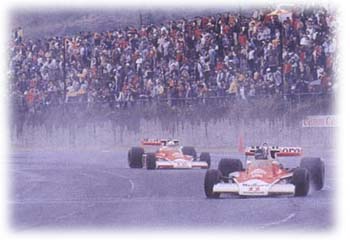 Of course, the first thing that springs to mind when thinking of Suzuka is the double clash between Ayrton Senna and Alain Prost. In two consecutive years, 1989 and 1990, the two titans clashed in dramatic fashion. In 1989 both were driving for McLaren and battling for the title. Seven laps from the finish-line, a fierce battle resulted in the two cars crashing into each other when Prost refused to move aside while Senna kept his line. The crash immediately ended Prost's race, while Senna continued to the pits to get his nose-cone replaced. Of course, the first thing that springs to mind when thinking of Suzuka is the double clash between Ayrton Senna and Alain Prost. In two consecutive years, 1989 and 1990, the two titans clashed in dramatic fashion. In 1989 both were driving for McLaren and battling for the title. Seven laps from the finish-line, a fierce battle resulted in the two cars crashing into each other when Prost refused to move aside while Senna kept his line. The crash immediately ended Prost's race, while Senna continued to the pits to get his nose-cone replaced.
Senna went on to win the race, only to be disqualified after the race for shortcutting after he was push-started back into the race. When McLaren protested, the FISA reviewed the case in detail and concluded the punishment was justified, as well as giving Senna a suspended six month ban and a $100,000 fine for dangerous behaviour in this and previous races. This resulted in a long lasting controversy between the Brazilian and the French FISA president Jean-Marie Balestre, who had been the one who took Senna's win away and with it the Brazilian's World Title. In fact, Senna even threatened quitting Formula One altogether at that time and while he never fulfilled that threat, two years later, when Senna won his third title, he openly accused Balestre of stealing his title in 1989.
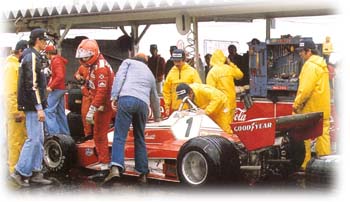 In the next year, the situation was different, as was the outcome. Directly after the start, heading into the first corner, Prost was leading when Senna came along the inside. Senna's McLaren crashed into the Frenchman's Ferrari and both drivers were out of the race. This gave the title to the Brazilian with the race in Australia still to go. Senna had gotten his revenge and his relationship with Alain Prost was now damaged beyond repair. In the next year, the situation was different, as was the outcome. Directly after the start, heading into the first corner, Prost was leading when Senna came along the inside. Senna's McLaren crashed into the Frenchman's Ferrari and both drivers were out of the race. This gave the title to the Brazilian with the race in Australia still to go. Senna had gotten his revenge and his relationship with Alain Prost was now damaged beyond repair.
Not only in these two years was Ayrton Senna the focus of attention in the Far East, but also in the years before and after. First in 1988, he won the race and with it the title in terrible weather conditions, demonstrating his mastery in the rain. Then after the two clashes, Senna waved past teammate Gerhard Berger to thank him for his work and allowed him to score victory. This example was later repeated by Mika Hakkinen in Australia. To conclude the Senna-Suzuka sensations, the Brazilian clashed with the new kid on the block Eddie Irvine in 1993. Ayrton Senna won the race, but went to the Ulsterman after the race, arguing the rookie had blocked him during the race. Irvine, back then just like he is now, wasn't impressed by the champion, which resulted in Senna punching him.
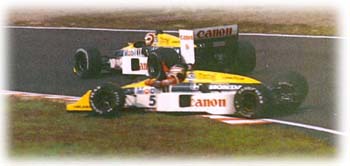 In recent years, Michael Schumacher and Damon Hill took over the parts of Senna and Prost in the ongoing Japanese drama. Both have won the race twice. Of these battles, 1994 stands out as the most exciting. In heavy rain, Schumacher and Hill showed a brilliant battle in race as well as in tactics. In the end Schumacher was just short of the win even though he was rapidly closing in on the Briton in the final stages of the race. In recent years, Michael Schumacher and Damon Hill took over the parts of Senna and Prost in the ongoing Japanese drama. Both have won the race twice. Of these battles, 1994 stands out as the most exciting. In heavy rain, Schumacher and Hill showed a brilliant battle in race as well as in tactics. In the end Schumacher was just short of the win even though he was rapidly closing in on the Briton in the final stages of the race.
However, the year after Schumacher ended up on top, scoring his ninth win of the year and giving Benetton its first constructors championship. Between the Benettons of Schumacher and Herbert, a little McLaren success was noted: Mika Hakkinen scored a second place for the British team. With his second of four podium finishes so far, the Finn proved that Suzuka is one of his best circuits.
In 1997, Michael Schumacher brought the title chase in position for a very exciting last race, by winning in Suzuka and taking the lead in the championship one point ahead of Jacques Villeneuve. The latter was the centre of attention this time. The Canadian was excluded from the race after having ignored yellow flags in free practice on Friday, carrying a suspended ban. Williams and Villeneuve appealed the FIA's decision and the Canadian was allowed to start after all. In the end Villeneuve finished fifth and Williams withdrew the appeal, making sure Villeneuve was disqualified from Suzuka and not from the championship deciding race at Jerez.
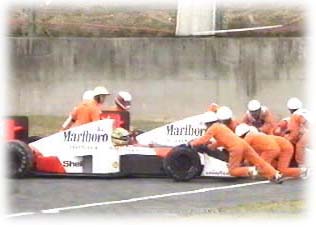 Last year, Suzuka was the final race of the championship, with this time the battle between Mika Hakkinen and Michael Schumacher. Hakkinen went into the race with a comfortable four point lead, but Schumacher dominated all weekend, ranking first in every session. During the starting procedure Jarno Trulli's Prost gave up, causing the procedure to be halted and the unfortunate Italian to be moved to the back of the grid. When the starting procedure was resumed, another car stalled. The whole world scanned the grid to see who it was this time. At the front a German was shaking his head in the car. Michael Schumacher's Ferrari had stalled and the championship candidate had to suffer the same fate as Jarno Trulli. Last year, Suzuka was the final race of the championship, with this time the battle between Mika Hakkinen and Michael Schumacher. Hakkinen went into the race with a comfortable four point lead, but Schumacher dominated all weekend, ranking first in every session. During the starting procedure Jarno Trulli's Prost gave up, causing the procedure to be halted and the unfortunate Italian to be moved to the back of the grid. When the starting procedure was resumed, another car stalled. The whole world scanned the grid to see who it was this time. At the front a German was shaking his head in the car. Michael Schumacher's Ferrari had stalled and the championship candidate had to suffer the same fate as Jarno Trulli.
In his struggle to get back to front, Schumacher was seriously obstructed by his archrival Damon Hill, who later smilingly acclaimed his radio wasn't functioning very well so he couldn't hear the team asking him to move over. After 32 laps, the final curtain fell for the German. Schumacher's right rear tyre blew up and his race was over, handing Mika Hakkinen his first World Championship title.
Japanese Grand Prix - Just the Facts
 This weekend's Formula One Japanese Grand Prix will be the 15th with that title - although two more Grands Prix have been held in the country under the Pacific Grand Prix title. They were held at Aida; the first two Japanese Grands Prix were held at Fuji in 1976 and 1977 but all the others have been held at Suzuka, from 1987 to the present day. Originally the Japanese Grand Prix was held for sports cars or Formula Two cars.
It isn't a particularly lucky circuit for Ferrari who have won twice there but McLaren have won five times while Benetton and Williams have each won three times. The only other winner was Lotus for whom Mario Andretti won the very first Japanese Grand Prix. In qualifying for that race, the entire 23 car field was covered by just 2.78s, last place being held by current medical car driver Alex Ribeiro. Gerhard Berger, Ayrton Senna, Damon Hill and Michael Schumacher have all won the Japanese Grand Prix twice.
 The Japanese Grand Prix's position at the end of the calendar means that it has frequently been the venue where the championship has been clinched. Ayrton Senna and Alain Prost settled two of their championships with collisions in 1989 and 1990. James Hunt, of course, famously won the World Championship at Fuji in 1976. Senna won all three of his championships at Suzuka; so did compatriot Nelson Piquet, as well as Damon Hill and Mika Hakkinen, while Michael Schumacher won his second at Aida. A week later, he won from pole position, including fastest lap at Suzuka. Of course, this year's championship will also be decided in Japan.
Two of those drivers, incidentally, clinched their titles with flag-to-flag wins: Hill and Hakkinen, while Hunt also won flag-to-flag but in 1977. Senna's first title came with a resounding one-two for Marlboro McLaren, leading home teammate Alain Prost in 1988 while Senna famously pulled over to let Berger win in 1991 for another McLaren one-two. A year earlier, Nelson Piquet and Roberto Moreno (standing in for the recently injured Alessandro Nannini) scored a one-two for Benetton.
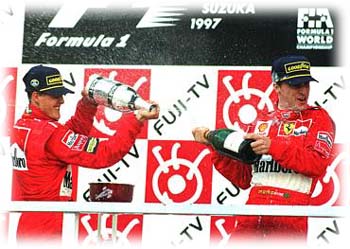 When it comes to qualifying, don't expect too much from Ferrari. They've never occupied the whole of the front row of the grid for the Japanese Grand Prix, whereas McLaren have three times and Williams have twice. However, Eddie Irvine's record is impressive with a progression of top six finishes in descending order starting with sixth in 1993 and culminating in second place last year.
Suzuka, incidentally, was originally constructed in 1962 as a test tack for Honda motorcycles. It was designed by Dutchman John Hugenholtz who also designed Jarama and Zandvoort. It features one of only two 'figures of eight' configurations in Formula One use; the other is at Fiorano, Ferrari's test track.
|







